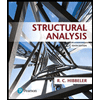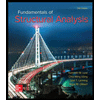
Fundamentals Of Structural Analysis:
5th Edition
ISBN: 9781260083330
Author: Leet, Kenneth
Publisher: MCGRAW-HILL HIGHER EDUCATION
expand_more
expand_more
format_list_bulleted
Concept explainers
Question
Chapter 3, Problem 13P
To determine
Calculate the reactions at A and G.
Expert Solution & Answer
Want to see the full answer?
Check out a sample textbook solution
Students have asked these similar questions
For the structural frame below, draw the shear force (VFD) and bending moment (BMD) diagrams for each of the three members of the frame. The frame is pin connected at A, C and D and fixed at joint B.Find:VFD & BMD for segment AB VFD & BMD for segment BCVFD & BMD for segment CD Reaction Forces VFD Equations BMD EquationsFree Body Diagrams
Determine the horizontal and vertical reactions at A and C for the two member frame below. Use P1 = 3.2 kN, P2 = 14.5 kN/m, L1 = 3.3 m, and L2 = 2.3 m. Free Body DiagramsTriangular Load Use of Pin Reaction Forces
Determine the reaction forces at supports A and C for the compound beam. Assume C is fixed, B is a pin, and A is a roller. Use P1 = 16 kN/m, P2 = 21 kN, L1 = 3.5 m, L2 = 1.5 m, and L3 – 1.5 m. needs:Triangular Load Use of Pin Reaction Forcesfree body diagrams
Chapter 3 Solutions
Fundamentals Of Structural Analysis:
Ch. 3 - Prob. 1PCh. 3 - Prob. 2PCh. 3 - Prob. 3PCh. 3 - Prob. 4PCh. 3 - Prob. 5PCh. 3 - Prob. 6PCh. 3 - Prob. 7PCh. 3 - Prob. 8PCh. 3 - Prob. 9PCh. 3 - Prob. 10P
Ch. 3 - Prob. 11PCh. 3 - Prob. 12PCh. 3 - Prob. 13PCh. 3 - Prob. 14PCh. 3 - Prob. 15PCh. 3 - Prob. 16PCh. 3 - Prob. 17PCh. 3 - Prob. 18PCh. 3 - Prob. 19PCh. 3 - Prob. 20PCh. 3 - Prob. 21PCh. 3 - Prob. 23PCh. 3 - Prob. 24PCh. 3 - Prob. 25PCh. 3 - Prob. 26PCh. 3 - Prob. 27PCh. 3 - Prob. 28PCh. 3 - Prob. 29PCh. 3 - Prob. 30PCh. 3 - Prob. 31PCh. 3 - Prob. 32PCh. 3 - Prob. 33PCh. 3 - Prob. 34PCh. 3 - Prob. 35PCh. 3 - Prob. 36PCh. 3 - Prob. 37P
Knowledge Booster
Learn more about
Need a deep-dive on the concept behind this application? Look no further. Learn more about this topic, civil-engineering and related others by exploring similar questions and additional content below.Similar questions
- Determine all displacement components and internal reactions at node 2 using the stiffness method. Assume I = 300(10^6) mm4, A = 10(10^3) mm2, E = 200 GPa for each member. Use the values of L3=2.5m, L4=4.5m, w=12kN/m and P=10kN.arrow_forwardDraw the BMD of the frame on the compression side showing all salient values using the stifness method. Assume I = 300(10^6) mm4, A = 10(10^3) mm2, E = 200 GPa for each member. Use the values of L3=2.5m, L4=4.5m, w=12kN/m and P=10kN. Please show all workingarrow_forwardSchool of I- I- 30 ft C1 B1 B2 E G1 4 @ 8 ft Floor 13 Span C3 G2 4 @ 8 ft -I- 30 ft 1. Calculate the dead load, wp (kip/ft), applied to beam B2 based on tributary load analysis for the given loads and floor span direction. In addition to the weight of concrete, include an additional 25 psf dead load (total of fixed partitions, HVAC, and drop ceiling). Neglect the beam self-weight and the weight of the corrugated steel sheet metal. 2. Draw an FBD of beam B2 showing the calculated dead load, wp, and support reactions. 3. Report the maximum bending moment (kip-ft) in beam B2 due to dead load. 4. What is the minimum uniform live load, L. (psf), for this occupancy? 5. Calculate the live load, WL (kip/ft), applied to beam B2 based on tributary load analysis for the occupancy and floor span direction. 6. Draw an FBD of beam B2 showing the calculated live load, wL, and reactions 7. Report the maximum bending moment (kip-ft) in beam B2 due to live load. 8. Is live load reduction allowed for…arrow_forward
- P10.7 WP For the simply supported steel beam [E = 200 GPa; I = 129 × 106 mm²] shown in Figure P10.7, use the double-integration method to determine the deflection at B. Assume that L = 4 m, P = 60 kN, and w = 40 kN/m. A B FIGURE P10.7 Warrow_forwardWhen calculating the minimum force P required to prevent motion of the wheel....What is the angle beta to be used in the equation for belt frictionwhen working with this system?Which tension would be T2?arrow_forward4.5m 4.5m 4.5m 20 4m A- Intermediate flat plate floor, story height=2.75 m, t=190 mm, f'c=20 MPa for slabs and f'c=35 MPa for columns. All columns are 400×400mm. Find all DF for the interior equivalent frame shown. 6m 6marrow_forward
- 2. Determine the reactions, and shear and moment diagrams. EI= 50000 kip-ft2[50pts] Note: You can use the virtual work method/ Table to calculate fij terms. A 18 ft B 40 k 6 ft Carrow_forwardbased on the gantt chart shown what is the most appropriate next step to prevent project delay? A) Shift non-critical tasks to make room for Task B B) Reassign the graming worrk to a different subcontractor immediately. C) Extend the project deadline by one week D)Analyze float in adjacent task and consider crashing task Barrow_forwardAccording to the site safety layout what is the biggest potential safety risk? A) PPE Station Located too lose to a heavy equipment zone B) Emergency assemlt point is near the parking lot C)Fire Extingishers are placed every 50 ft. D) Only one site entrance is open for deliveriesarrow_forward
- which method is most effective for controlling costs and tracking budget performance during a construction project? A)SWOT Analysis B)Root Cause Analysis C)Gantt Chart D) Value Stream Mappingarrow_forward9.44 High-speed passenger trains are streamlined to reduce shear force. The cross section of a passenger car of one such train is shown. For a train 81 m long, estimate the shear force (a) for a speed of 81.1 km/hr and (b) for one of 204 km/hr. What power is required for just the shear force at these speeds? These two power calculations will be answers (c) and (d), respectively. Assume T = 10°C and that the boundary layer is tripped at the front of the train. 10 m Problem 9.44arrow_forwardA monitoring program for water flow in an unsaturated soil layer includes sensors to measure the volumetric water content and suction up to a depth of 3 m. The soil is a sand whose hydraulic properties are shown in the figures below. Using the drying curves, draw a quantitatively accurate set of vertical profiles of volumetric water content, pressure head, and total hydraulic head versus depth (with a datum at the base of the soil layer and an elevation head that is positive upward) expected for the following cases:A) The volumetric water content (moisture content) is 10% throughout the profile B) The pressure head is -150 cm throughout the profile C) The total hydraulic head is 100 cm throughout the profile (static no-flow case) Also, report the hydraulic gradient for each case. For parts (a) and (b), calculate the flow rates through the profile. For part (c), calculate the depth to the water table.arrow_forward
arrow_back_ios
SEE MORE QUESTIONS
arrow_forward_ios
Recommended textbooks for you

 Structural Analysis (10th Edition)Civil EngineeringISBN:9780134610672Author:Russell C. HibbelerPublisher:PEARSON
Structural Analysis (10th Edition)Civil EngineeringISBN:9780134610672Author:Russell C. HibbelerPublisher:PEARSON Principles of Foundation Engineering (MindTap Cou...Civil EngineeringISBN:9781337705028Author:Braja M. Das, Nagaratnam SivakuganPublisher:Cengage Learning
Principles of Foundation Engineering (MindTap Cou...Civil EngineeringISBN:9781337705028Author:Braja M. Das, Nagaratnam SivakuganPublisher:Cengage Learning Fundamentals of Structural AnalysisCivil EngineeringISBN:9780073398006Author:Kenneth M. Leet Emeritus, Chia-Ming Uang, Joel LanningPublisher:McGraw-Hill Education
Fundamentals of Structural AnalysisCivil EngineeringISBN:9780073398006Author:Kenneth M. Leet Emeritus, Chia-Ming Uang, Joel LanningPublisher:McGraw-Hill Education
 Traffic and Highway EngineeringCivil EngineeringISBN:9781305156241Author:Garber, Nicholas J.Publisher:Cengage Learning
Traffic and Highway EngineeringCivil EngineeringISBN:9781305156241Author:Garber, Nicholas J.Publisher:Cengage Learning


Structural Analysis (10th Edition)
Civil Engineering
ISBN:9780134610672
Author:Russell C. Hibbeler
Publisher:PEARSON

Principles of Foundation Engineering (MindTap Cou...
Civil Engineering
ISBN:9781337705028
Author:Braja M. Das, Nagaratnam Sivakugan
Publisher:Cengage Learning

Fundamentals of Structural Analysis
Civil Engineering
ISBN:9780073398006
Author:Kenneth M. Leet Emeritus, Chia-Ming Uang, Joel Lanning
Publisher:McGraw-Hill Education


Traffic and Highway Engineering
Civil Engineering
ISBN:9781305156241
Author:Garber, Nicholas J.
Publisher:Cengage Learning